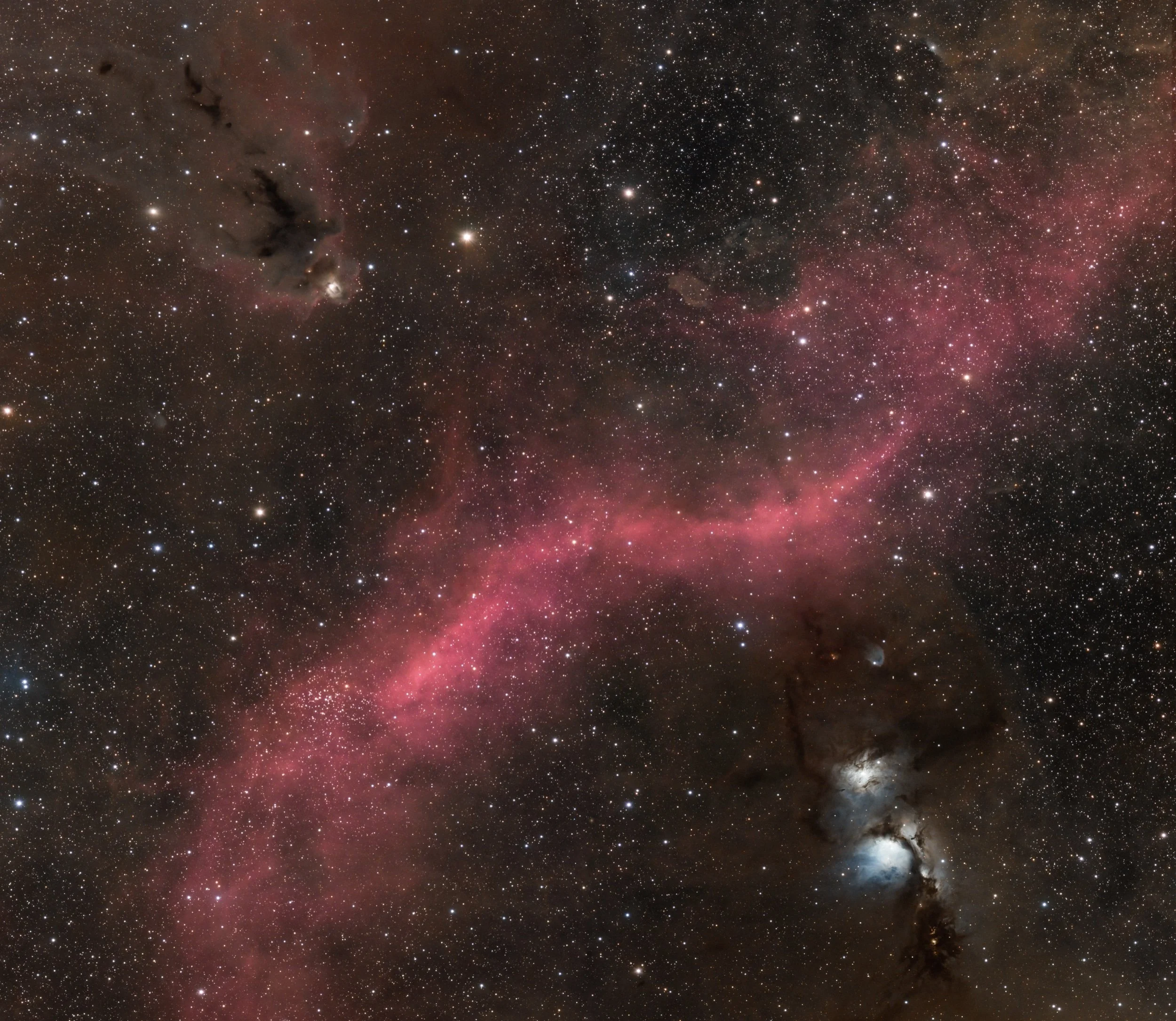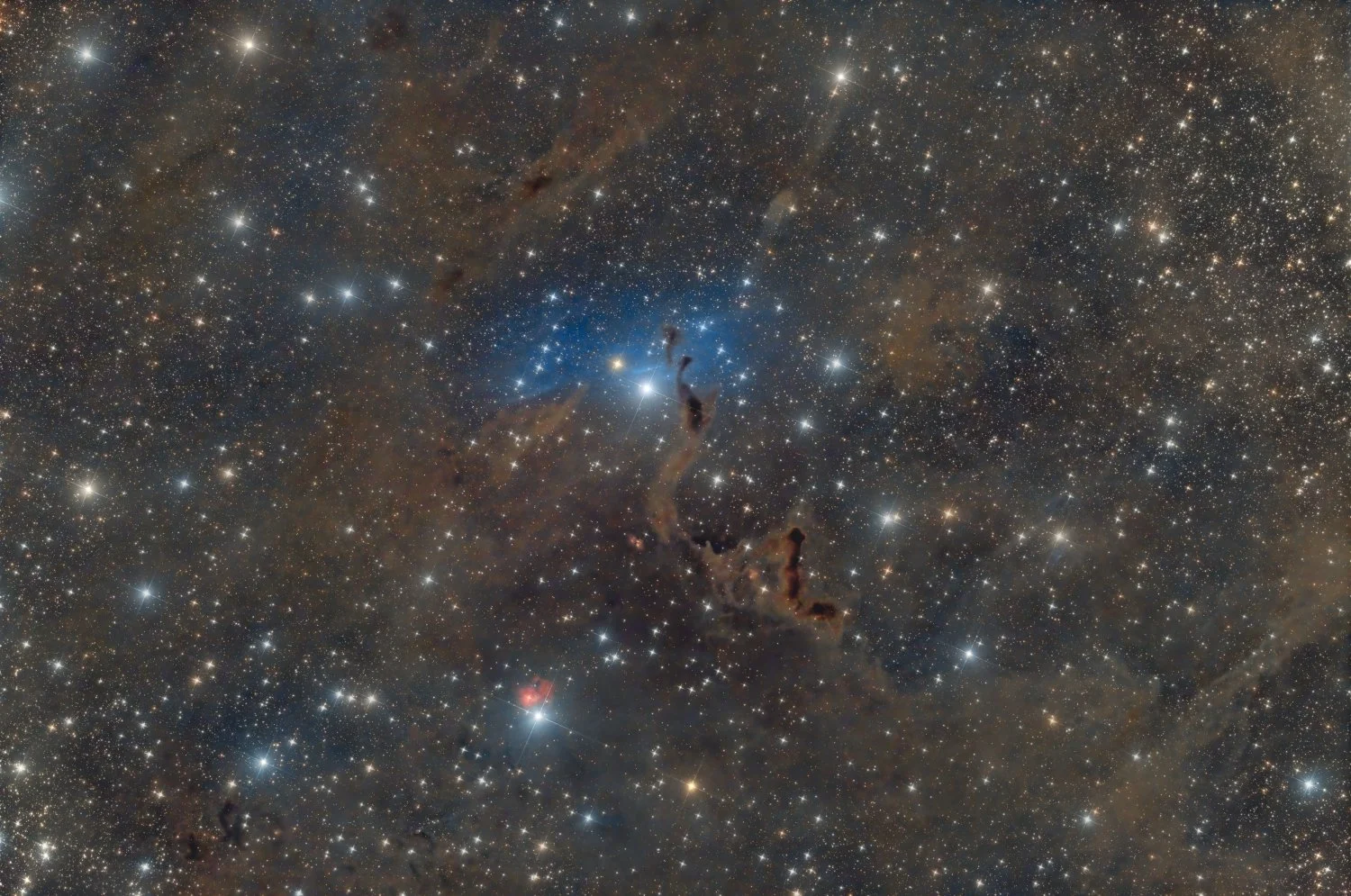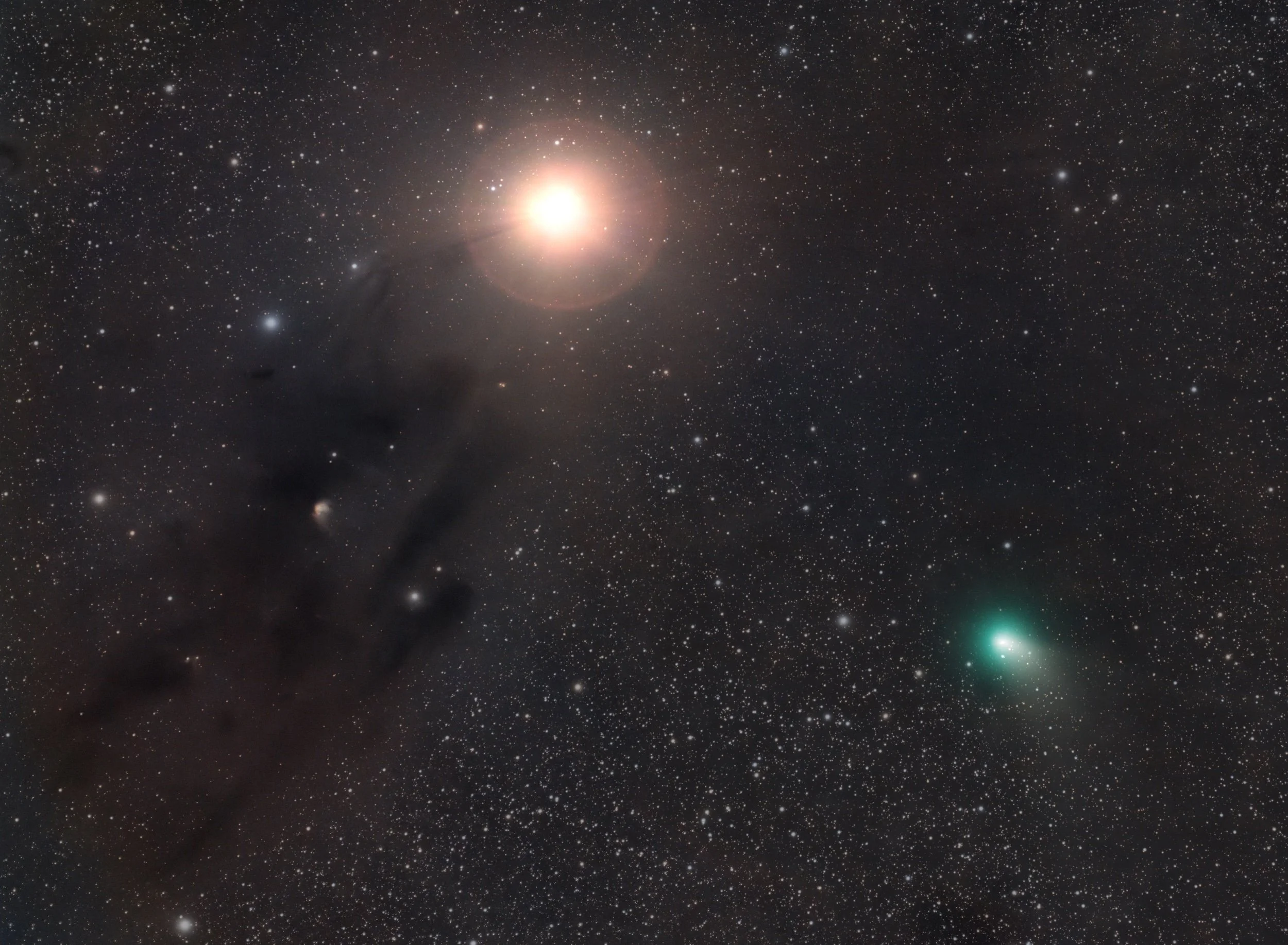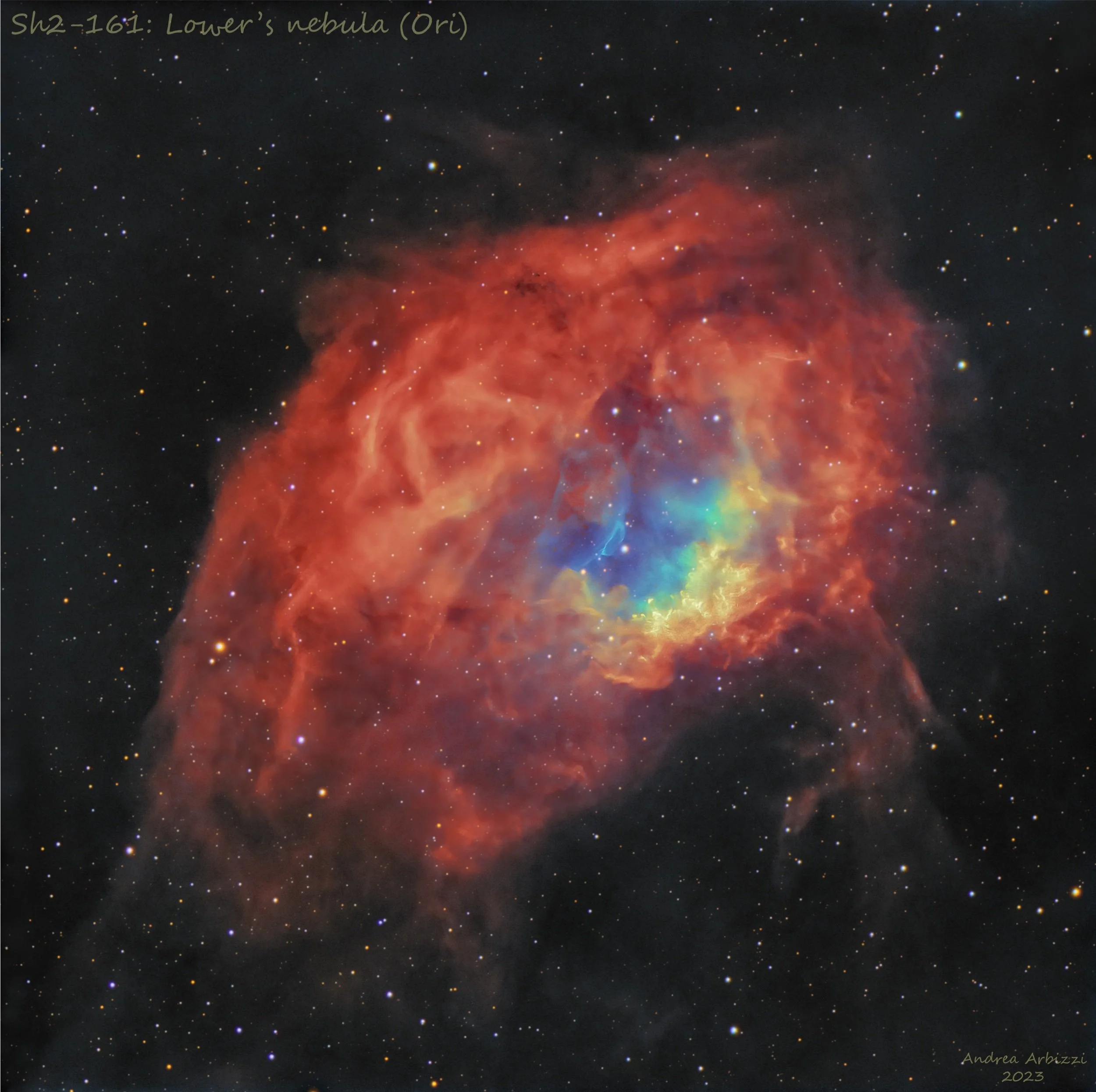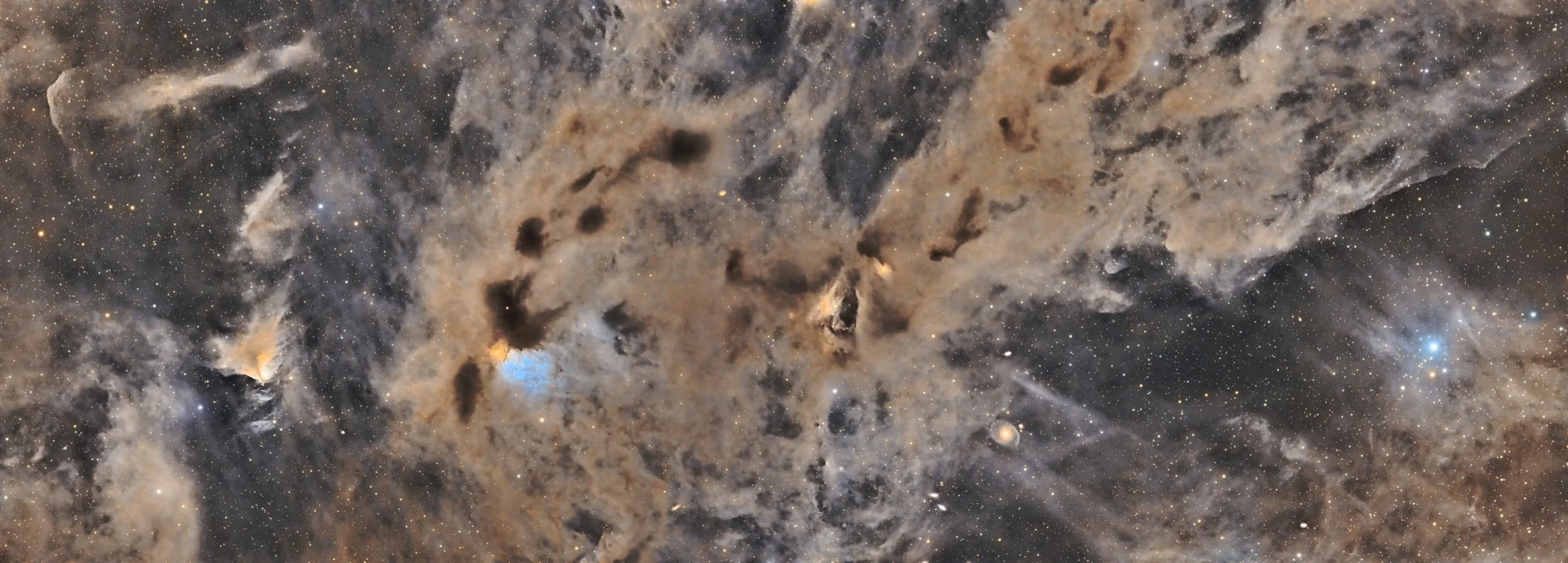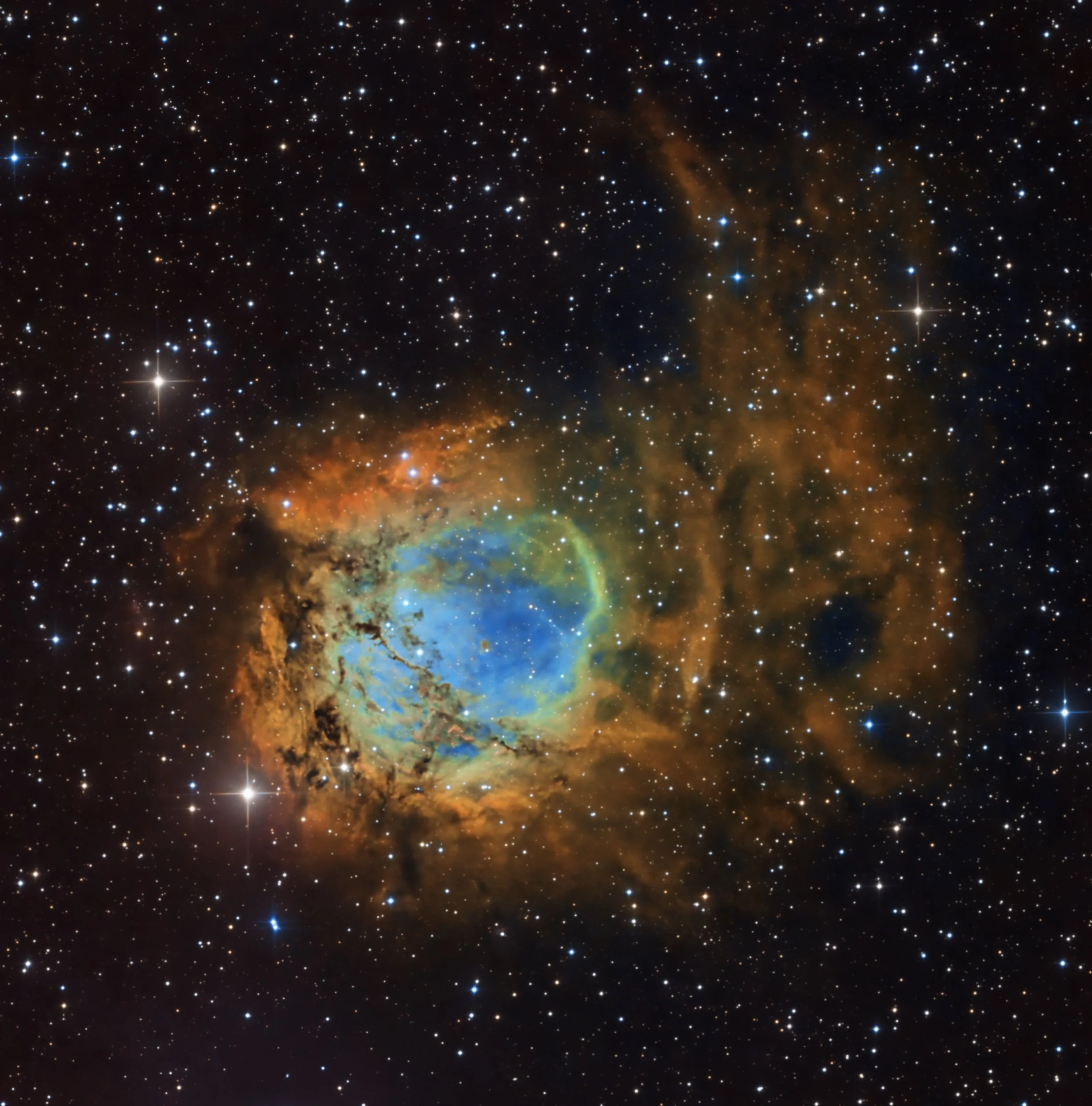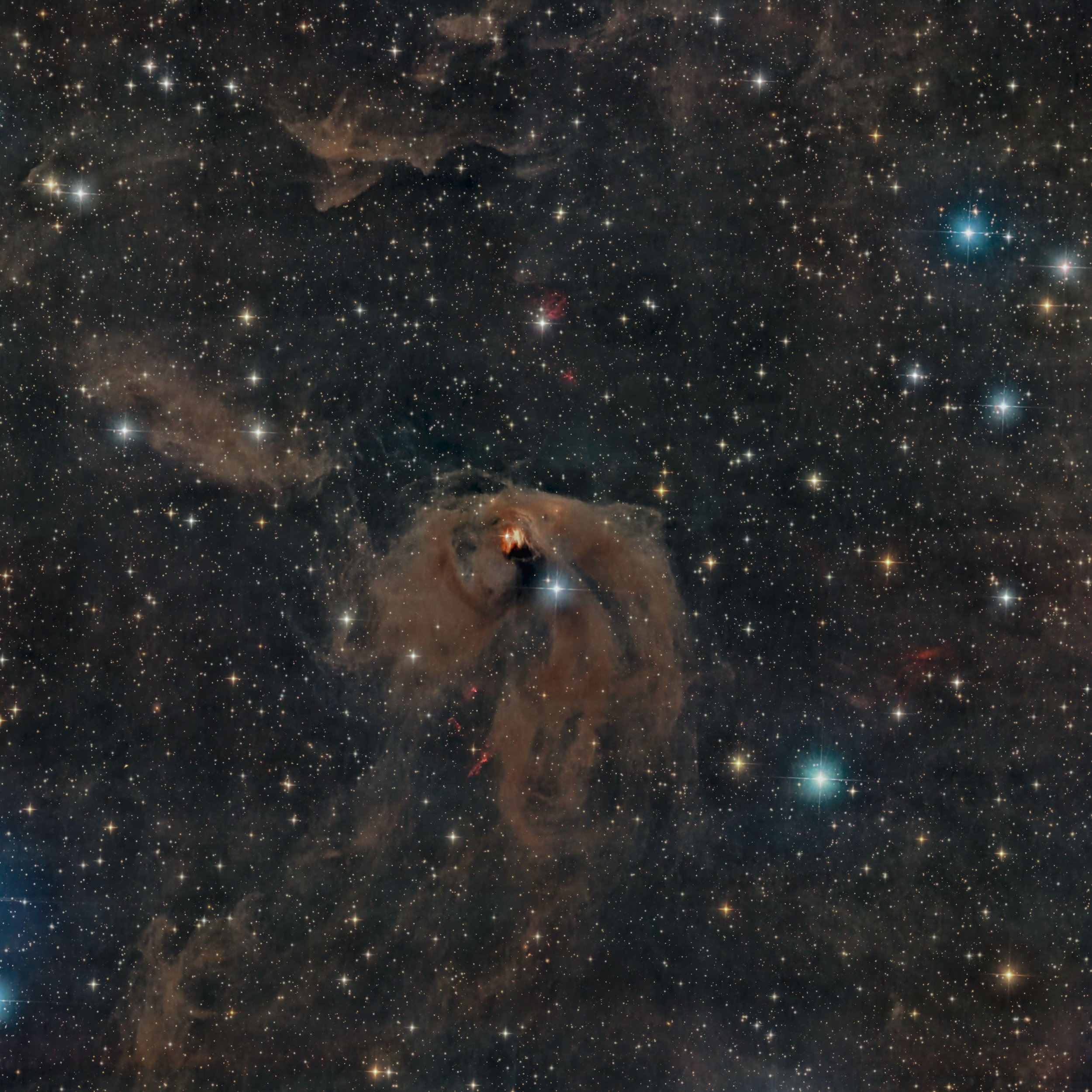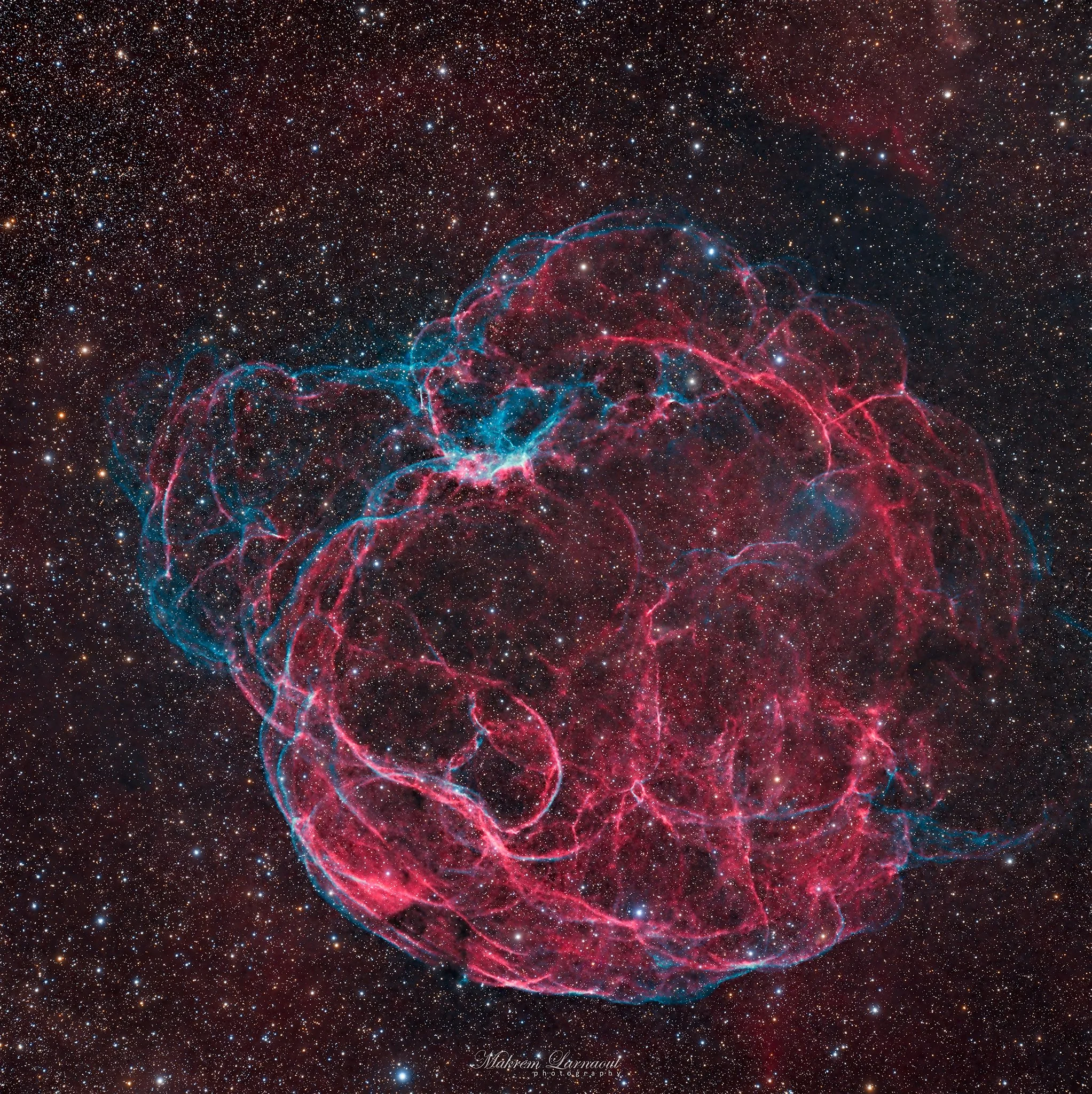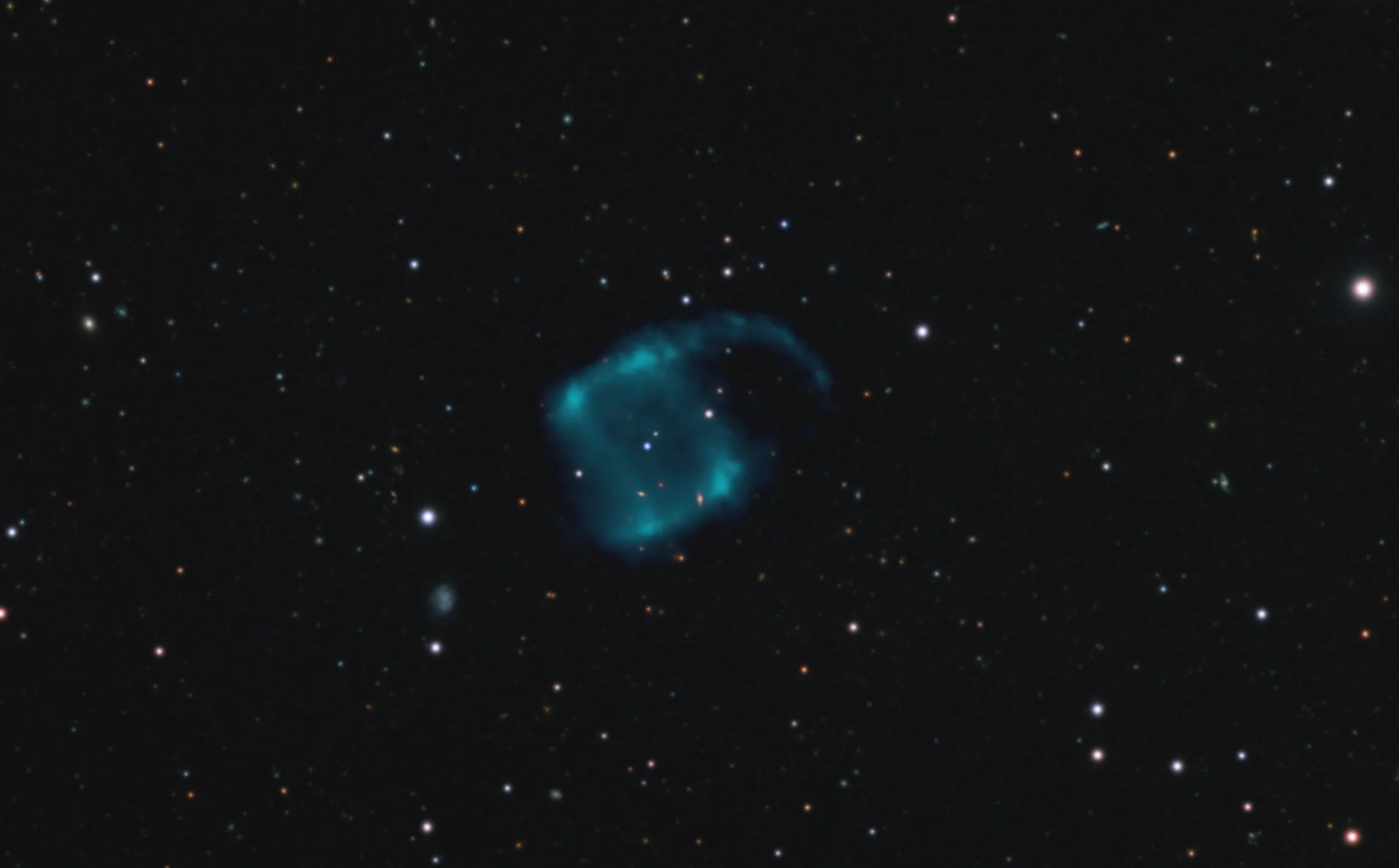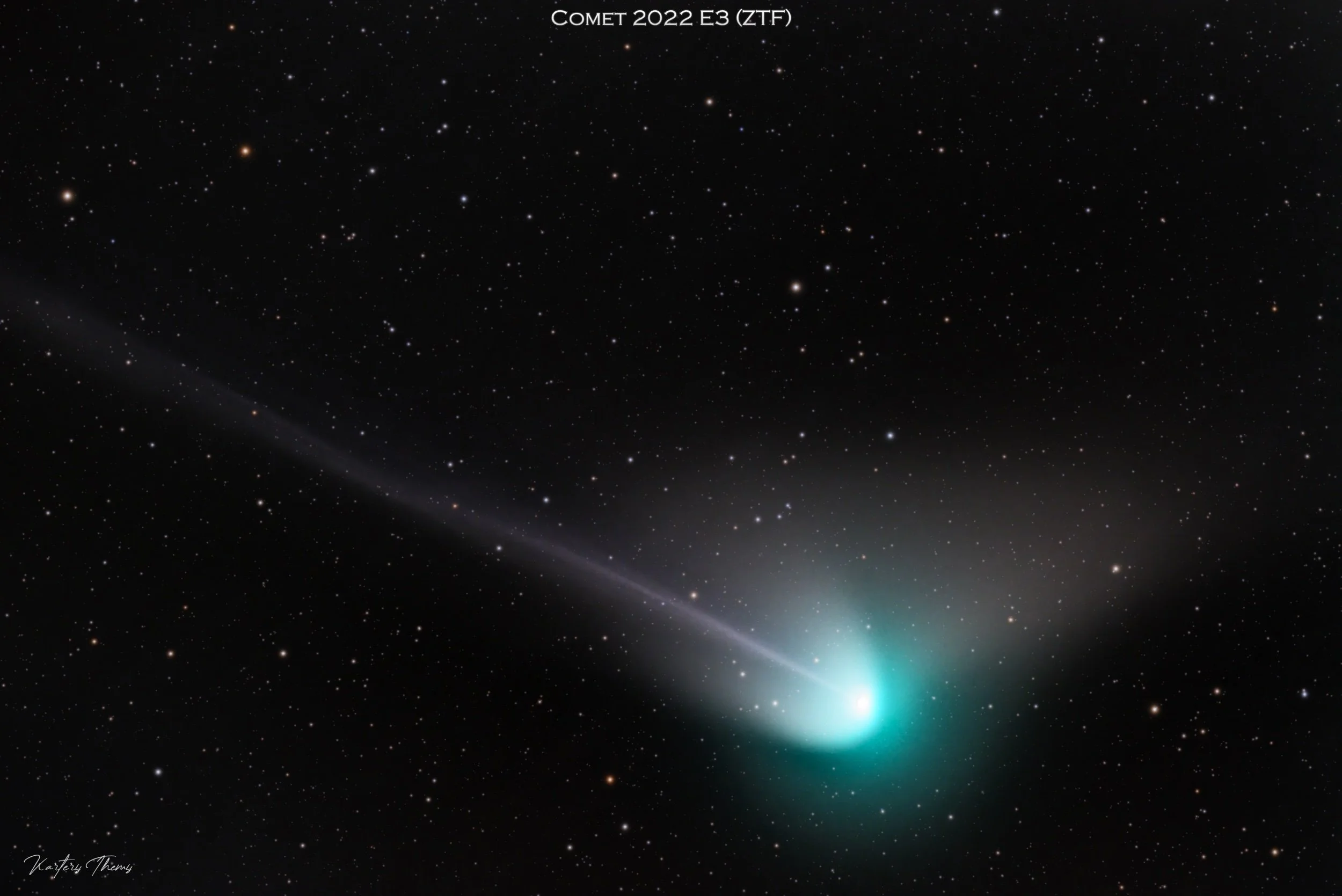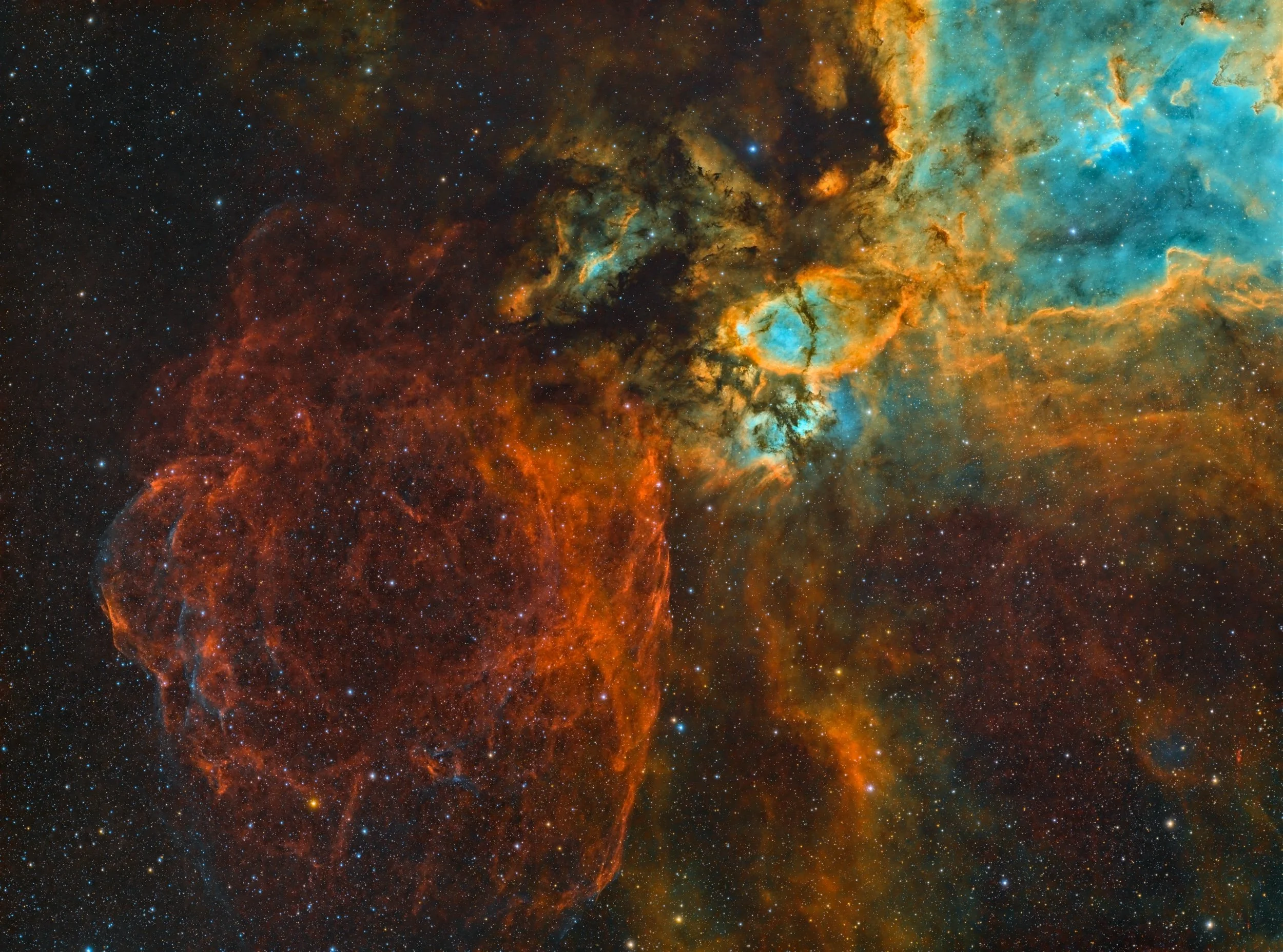
AAPOD2 Image Archives
Barnard's Loop and cloud complex with M78 & LDN1622
Image Description and Details : Here is the area that includes M78 and LDN1622 separated by the Barnard loop.
This view offers us a magnificent mix of reflection nebula (M78), emission nebula (Barnard loop) and dark nebula (LDN1622).
Shooting information:
Place / date: La Fosse (Manhay, Belgium) - 13 & 14/02/2023
Constellation: ORION
Acquisition: 150 x 120 sec (05h00)
Mount: Skywatcher EQ6R pro
Optical tube: Celestron RASA 8
Camera: ZWO Asi2600MC (gain 100 / -20°)
Filter: None
Accessories: ZWO EAF - ZWO ASIAIR PRO
Processing: Siril - Pixinsight - Lightroom
Copyright: Werny Michael
NGC 1514
Image Description and Details : NGC 1514 is a planetary nebula in the constellation Taurus. It is also known as the Crystal Ball Nebula. It is 1520 light years from Earth. The nebula originated from a binary star system with the designation HD 281679 from the Henry Draper Catalogue. The bright, visible component is a giant star, while the nebula-generating companion is now a hot, sub-luminous O-type star. The two have one of the longest known orbits for any planetary nebula, with a period of about 9 years.
Captured on my remote observatory in Spain.
Scopes: APM TMB LZOS 152 Refractors
Cameras: QSI6120wsg8
Mounts: 10Micron GM2000 HPS
A total of 35 hours (HaOIIIRGB)
Copyright: Copyright: Peter Goodhew
LDN 1355
Image Description and Details: I present to you a dark nebula nicknamed LDN 1355 Located in the Constellation Cassiopeia, LDN 1355, together with the surrounding dark nebulae LDN 1357 and 1358, formed an interesting sight of an extended "helping hand". There is also a blue reflecting nebula VdB 9 lit by the star SU Cas. Then another reflective nebula VdB 7 with a hint of red and blue, surrounding a variable star RZ Cas.acquisitions: 413 exposures of 240s for a total of 27H30 Takahashi Epsilon 130DZWO ASI2600MC cameraL-pro filterIoptron mount CEM60-ECpixinsight and Photoshop processing Copyright: lamagat frederic
The Crab Nebula
Image Description and Details : The Crab Nebula (catalogue designations M1, NGC 1952, Taurus A) is a supernova remnant in the constellation of Taurus. Corresponding to a bright supernova recorded by Chinese astronomers in 1054, the nebula was observed later by English astronomer John Bevis in 1731. The nebula was the first astronomical object identified with a historical supernova explosion.
At an apparent magnitude of 8.4, comparable to that of Saturn's moon Titan, it is not visible to the naked eye but can be made out using binoculars under favourable conditions. The nebula lies in the Perseus Arm of the Milky Way galaxy, at a distance of about 6,500 ly from Earth. It has a diameter of 11 ly.
At the center of the nebula lies the Crab Pulsar, a neutron star 28–30 kilometres across with a spin rate of 30.2 times per second, which emits pulses of radiation from gamma rays to radio waves.
Copyright: Ruben Barbosa
Comet conjunction
Image Description and Details : I took this image in ruta b-55 near Antofagasta, Chile, with my astrophotography equipment. It was taken at 22:00 to 00:00 local time 10th february.
The objects in the frame are the comet ztf, mars, the dark nebula B22 (reflected a bit in mars halo) and ic 2087.
The equipment used was askar fra400 with his reducer (F3.9), zwo asi2600mm, astronomik lrgb filters and ioptron cem70.
The adquition details are:
L: 25 x 120”
R: 25 x 60”
G: 25 x 60”
B: 25 x 60”
Copyright: S. Emiliog
Lower’s Nebula
Image Description and Details : Sh2-261, also known as Lower’s Nebula (after Harold and Charles Lower discovered it in 1939), is an emission nebula found on the outermost edge of our Milkyway between the Orion and Perseus arm.
APM SD Apo (Fpl53) 140 F4,6 (644 mm)
ZWO ASI 533MC Pro + iOptron GEM45
Feb 2023
Optolong L-Ultimate (3 nm): 111X600"
Optolong Uv Ir cut: 30X60” (star color)
Tot: 19h
Modena (Sqm 18.3-18.9 Bortle 7,5-8), Italy
Copyright: Andrea Arbizzi
MOLECULAR CLOUDS ON TAURUS
Image Description and Details : 2 tiles composition of molecular clouds on Taurus. LRGB Image. FRANCISCO SERRANO & CARLOS LUNA
Francisco Serrano Setup:
- 121x120RGB per tile. Qhy294c, optolong uv/ir, zwo eaf, eq6r pro, sw esprit ed80, QHY 5P-IIC, Svbony SV165
Carlos Luna Setup:
- 180x120L with asi 1600mm, zwo efw 5 posiciones, RB focus Merlin, eq6pro, TS 80 photoline, reductor TS 0.79x, 8x50+qhy5llL, gaius S
Copyright: 2 tiles composition of molecular clouds on Taurus. LRGB Image. FRANCISCO SERRANO & CARLOS LUNA
Francisco Serrano Setup:
- 121x120RGB per tile. Qhy294c, optolong uv/ir, zwo eaf, eq6r pro, sw esprit ed80, QHY 5P-IIC, Svbony SV165
Carlos Luna Setup:
- 180x120L with asi 1600mm, zwo efw 5 posiciones, RB focus Merlin, eq6pro, TS 80 photoline, reductor TS 0.79x, 8x50+qhy5llL, gaius S
Name: FRANCISCO SERRANO
A 62-hour widefield image of Orion
Image Description and Details : This is easily one of my most ambitious astrophotography projects to date. Given that I’m fairly limited by my dslr in terms of imaging very dim objects, I decided to dump as much time on Orion as possible to see how much dust and gas in the region I could reveal. I was struck by how much wispy H-alpha gas didn’t line up exactly with the dust in the region – it was very cool to see the differences in ionized and non-ionized gas.
Equipment:
Nikon D800
200mm F4 lens
GEM 28
NINA
Nikonhacker
Acquisition
ISO 800, F4
Taken from a bortle 1 zone in Northwest CT
1240 x 180s (62 hours) – Taken on 12/18/2022, 12/20/2022, 12/21/2022, 12/22/2022, 12/23/2022, 12/24/2022, 12/27/2022, 1/18/2023, 1/21/2023, 1/22/2023, 1/23/2023. 1/24/2023
Copyright: William Ostling
SH2-301
Image Description and Details : This is an image of SH2-301. It is an emission and reflection nebula about 13,000 light years away in the constellation Canis Major.
Telescope: Planewave CDK-24
Camera: FLI PL9000
Mount: Mathis MI 1000/1250
Ha: 20x10 minutes (binned 1x1)
OIII: 20x10 minutes (binned 1x1)
SII: 20x10 minutes (binned 1x1)
Copyright: Bernard Miller
ngc 1555 Hind's nebula
Image Description and Details : NGC 1555, sometimes known as Hind's Variable Nebula, is a variable nebula, illuminated by the star T Tauri, located in the constellation Taurus. It is also in the second Sharpless catalogas 238. It is a Herbig–Haro object. The nebula was discovered on October 11, 1852, by John Russell Hind.
RC Astrosib 20" F2.7 + camera FLI 4040
CCDautopilot+the skyX + Pixinsight + Photoshop
Total RGB=18h40mn
From E-eye Fregenal de la sierra (Spain) in remote
Copyright: Georges Chassaigne
Gassendi, an amazing crater
Image Description and Details : Gassendi, an amazing crater.
Normally, when we start astrophotography, our first target is the Moon. Our old Lua is generous because it works well even on the most modest instruments. A simple 60mm scope and a cell phone already allow for interesting photos.
But shooting the moon in high resolution requires good apertures, proper collimation and a dedicated camera, and it can be difficult work if the photo is close to the terminator.
But, in fact, it is the photos close to the terminator that reveal the good lunar photographers, as they require adequate control of light, both at the time of capture and in subsequent processing.
In this photo we have Gassendi very close to the terminator, and with the sun at an extremely low angle, the relief of the floor stands out in a dazzling way. Its rhymes are usually very evident but with the sun low we can clearly see how irregular the floor of this remarkable crater is.
Gassendi is one of the main lunar craters, with its 114 km in diameter, it is very old formed in the Nectariam period about 3.92 billion years ago.
It is an impact crater with Fractured Interior (FFC), which was modified by volcanic action after its formation, probably huge lava flows gushed through the cracks in the floor, causing numerous stress fractures to form in its interior from the reservoirs. of lava, this made it quite shallow in relation to its diameter - just 2.8 km deep.
When observed through spectroscopic analysis, the Gassendi crater has a "behavior" very different from any other lunar crater (Mikhail 1979). High-resolution studies performed in near-infrared light (Chevrel and Pinet 1990, 1992) indicated the presence of extrusive volcanic material (that is volcanic material that flows to the surface and then crystallizes) limited to the adjacent southern part of the Gassendi floor. to the floor of the Mare Humorum.
Interpretation of the data also suggested that major extrusive volcanism may have occurred in the eastern portion of the floor, as indicated by the significant presence of pyroxene, which corresponds to visible volcanic features. The western part of the crater floor, away from the geometric continuation of the western rim of Mare Humorum, is composed of rich upland material.
The difference between the west and east sides of Gassendi with intensely fractured soil could be strongly linked to the early thermal history of Mare Humorum.
I've already taken countless photos of Gassendi, but the result of this one with the sun very low really surprised me. A pleasant surprise, which shows that each photo is unique in itself and each moment is unrecoverable if we don't know how to take advantage of it.
Copyright: Astroavani
SH2-308
Image Description and Details : SH2-308 - commonly dubbed as the Dolphin-Head Nebula by astrophotographers - a HII region located near the center of the constellation Canis Major.
It is thought to have formed about 70,000 years ago by the ejection of the outer layers of the star EZ Canis Majoris.
Data credit : Aygen Erkaslan / Telescope Live
Date : 2022-2023
Location : El Sauce Obs, Chile
Scope : CDK 24" (F/6.8)
Camera : FLI PL 9000
Filters : Ha, Oiii, RGB
Integration time : 6H55
Copyright: Aygen Erkaslan
SH2-240 Spaghetti Nebula
Image Description and Details : Imaging Telescopes Or Lenses
Samyang 135mm F2.0 ED UMC
Imaging Cameras
ZWO ASI533MC Pro
Mounts
Sky-Watcher EQ6-R Pro
Filters
Optolong L-eXtreme 2"
Accessories
ZWO ASIAIR Pro
Software
Adobe Photoshop · Pleiades Astrophoto PixInsight
Guiding Telescopes Or Lenses
ZWO 30mm Mini Guider Scope
Guiding Cameras
ZWO ASI120MM
Acquisition details
Dates:
Jan. 28, 2023 · Jan. 29, 2023
Frames:
Optolong L-eXtreme 2": 60×300″(5h) ISO100 f/3.2 -10°C bin 1×1
Optolong L-eXtreme 2": 56×300″(4h 40′) (gain: 100.00) f/3.2 -10°C bin 1×1
Integration:
9h 40′
Copyright: Makrem Larnaoutn
The Boogeyman in Orion - LDN 1622 Dark Nebula
Image Description and Details : And here it is the last rendering of the Dark Nebula LDN 1622 - also dubbed the Boogeyman.
The earliest version didn't really match my requirements. Hence this redux from scratch with overall better contrast, details, colors management.
Data credit : Aygen Erkaslan
Date : lights gathered during the first three weeks of Jan 2023.
Location : own remote observatory, Spain
Scope : TOA 130
Camera: ASI 6200 mm pro
LRGB_Ha
Intégration time : 24H
Copyright: Aygen Erkaslan
NGC 2626
Image Description and Details : It has components of reflection nebula, emission nebula and dark (absorption) nebula which makes it both challenging and cool. It is located in Vela approximately 4200 light years from Earth.
The reflection nebula is primarily illuminated by a B1 star (CD-40 4432) and is ionized by the O8 quadruple star system HD 73882.
Imaged in LRGB on the Planewave CDK 700 at Observatorio El Sauce, Chile.
Image Data Acquired and preprocessed by: Mike Selby at throughlightandtime.com
Processed using Pixinsight and Photoshop.
Copyright: Mike Selby and Gowri Visweswara
Ltnf 1
Image Description and Details : LTNF 1 is an extremely faint and rarely-imaged highly-evolved planetary nebula in the constellation Ursa Major. It is a high-excitation nebula with an eclipsing binary star system (BE Ursae Majoris) at its centre which has resulted in its unusual morphology. It is around 5,000 light years from Earth. It is so transparent that galaxies can be seen through it. It was discovered by James Liebert, Richard Tweedy, Ralf Napiwotzki and Michael Fulbright in 1995. A joint project with Sven Eklund.
Scopes: APM TMB LZOS 152 Refractors and Celestron C14 Edge HD
Cameras: QSI6120wsg8 and ZWO ASI6200MM Pro
Mounts: 10Micron GM2000 HPS and 10Micron GM3000 HPS
A total of 73 hours 25 minutes (OIIILRGB)
Copyright: Copyright: Peter Goodhew, Sven Eklund
Ic2118
Image Description and Details : While i was waiting for the comet I went to “Witch's” . Photo taken from my backyard on 19 Jan 2022 in Terceira Island Azores, Portugal
Hyperstar C8 v4 390mm - Cem40EC - Asi071MC - Uv/IRCut - 100x1min
IC 2118 (also known as the Witch's Head Nebula due to its shape) is an extremely faint reflection nebula believed to be an ancient supernova remnant or gas cloud illuminated by the nearby supergiant star Rigel in the constellation of Orion.
Copyright: João Berbereia
C/2022 e3 ztf
Image Description and Details : First try with the new Pegasus Astro NYX-101 mount and my first astrophotography on a comet.
Imaging Telescope: Sky-Watcher Esprit 100ED
Imaging Cameras: QHYCCD QHY268 Pro M
Mounts: Pegasus Astro NYX-101
Filters: Baader Blue (B-CCD) 36 mm · Baader Green (G-CCD) 36 mm · Baader Red (R-CCD) 36 mm · Baader UV/IR Cut / Luminance 36 mm
Accessories: Intel NUC 10 · Pegasus Astro FlatMaster 150 · Pegasus Astro FocusCube2 · Pegasus Astro Ultimate Powerbox 2 · QHYCCD PoleMaster · QHYCCD QHYCFW3-M-US · QHYCCD QHYOAG-M
Software: Adobe Photoshop · Open PHD Guiding Project PHD2 · Pleiades Astrophoto PixInsight · Stefan Berg Nighttime Imaging 'N' Astronomy (N.I.N.A. / NINA)
Bortle:4
Exposures: All fits 60sec-Lum~27min Red~25min Green~25min Blue 25min.
Calibration Frames: Flats 10 - Darks 15 - Dark Flats 10
Copyright: Karteris Themis
IC 1805 and accompanied by this magnificent HB3 supernova remnant.
image details:
Ts optics 62/297 quintuplet
Ioptron GEM45
ZW0 asi 1600 mm pro
Pixinsight and photoshop
Antlia 3nm Narrowband H-alpha 1.25": 265×300″(22h 5′) (gain: 139.00) f/4.8 -20°C bin 1×1
Antlia 3nm Narrowband Oxygen III 1.25": 102×600″(17h) (gain: 139.00) f/4.8 -20°C bin 1×1
Antlia 3nm Narrowband Sulfur II 1.25": 102×600″(17h) (gain: 139.00) f/4.8 -20°C bin 1×1
Astronomik Deep-Sky Blue 1.25": 50×120″(1h 40′) (gain: 0.00) f/4.8 -20°C bin 1×1
Astronomik Deep-Sky Green 1.25": 50×120″(1h 40′) (gain: 0.00) f/4.8 -20°C bin 1×1
Astronomik Deep-Sky Red 1.25": 50×120″(1h 40′) (gain: 0.00) f/4.8 -20°C bin 1×1
Intégration:
61h 5′
Copyright: PUIG Nicolas
Vela Supernova Remnant
Image Description and Details : Vela Supernova Remnant
This is one of my favourite regions.
7 hours of 180s and 300s subs taken over 3 nights. (Shorter subs on a windy night).
Taken from my back yard here in Western Australia, Bortle 2 skies.
Equipment: Askar ACL200 with quad band filter, Skywatcher EQ6-R mount, ZWO ASI294MC-pro camera. ZWO ASIAIR-plus
Processed with Astropixel processor and Pixinsight
Copyright: Copyright: Michelle Bennett

